Gates of Belgrade
This article describes 23 gates of Belgrade.
Roman gates
Remains of southeastern gate of the Singidunum's castrum were found when adapting the building of the Belgrade Library, with one of its towers now being in the library depot and the other across the street in the small park with Milan Rakić's bust. The gate was located exactly at the end of Knez Mihailova and entrance of Kalemegdan park, at 44°49′12″N 20°27′12″E / 44.82000°N 20.45333°E. Thus this entrance stayed at the same place for nearly 2,000 years.[1]
Northwestern gate of the castrum was located roughly at the same place as today's Defterdar's Gate.[2]
Fortress gates
Upper city gates
These are gates in the walls of the Upper City of the Belgrade Fortress. Gates that are connected to each other are not exactly aligned. This was done to prevent use of siege engines on the inner gate, if the outer gate would be breached.
| Name | Photograph | Built | Location | Description |
|---|---|---|---|---|
| Clock Gate | 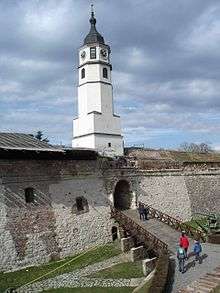 |
17th century | 44°49′23″N 20°27′2″E / 44.82306°N 20.45056°E | Southeastern gate in the innermost city wall, it is connected via a bridge to the Inner Stambol Gate. The gate got its name as it is located directly under the Clock Tower. It was built in the 17th century by Venetian architect Andrea Cornaro, and also sometimes called Cornaro's Gate. |
| Defterdar's Gate |  |
44°49′26″N 20°26′56″E / 44.82389°N 20.44889°E | Northwestern gate in the innermost city wall, accessible only via a steep stairway. Entrance complex at the gate is partially preserved. | |
| Despot's Gate |  |
1404-1427 | 44°49′30″N 20°27′2″E / 44.82500°N 20.45056°E | Northeastern gate in the innermost city wall, located right next to the Despot's Tower. It is connected via a bridge to the Zindan Gate. The gate is named after Despot Stefan. The gate and tower are the best preserved medieval part of the fortress. |
| Inner Stambol Gate |  |
around 1750 | 44°49′21″N 20°27′3″E / 44.82250°N 20.45083°E | The main gate of the fortress. Southeastern gate in the second city wall, connected via a bridge to the Clock Gate, and via a land bridge to the outer ravelin, where the way forks towards Karadjordje's and Outer Stambol Gate. The gate is named after Istambul. |
| Karadjordje's Gate |  |
18th century | 44°49′18″N 20°27′3″E / 44.82167°N 20.45083°E | Southern gate of its ravelin. It is named after Karadjordje after he passed through it to conquer the fortress in 1806. To prevent re-use it was built shut in 1813, to be opened only after World War II. |
| King Gate |  |
around 1725 | 44°49′22″N 20°26′52″E / 44.82278°N 20.44778°E | Southwestern gate in the innermost city wall. The gate is descended to via a short stairway which passes next to the Roman Well. A bridge then connects it with the King Ravelin. |
| Leopold's Gate |  |
around 1690 | 44°49′30″N 20°27′6″E / 44.82500°N 20.45167°E | The outermost northeastern gate, connected via a bridge to the Zindan Gate. It was named after Leopold I. |
| Outer Stambol Gate |  |
1840-1860 | 44°49′20″N 20°27′7″E / 44.82222°N 20.45194°E | Eastern gate of its ravelin, it is named after Istanbul. |
| Southern Gate | Also called Baroque Gate, it existed right next to the Clock Gate and was built shut when the later was opened. Today it is turned into a museum. | |||
| Zindan Gate | mid-15th century | 44°49′33″N 20°27′5″E / 44.82583°N 20.45139°E | The middle southeastern gate, between two round towers. It is connected with bridges to the Despot's Gate on the inside and Leopold's Gate on the outside. Since the 18th century, the Ottoman Empire used towers' basement as dungeon, a zindan, hence the name of the gate. |
Lower city gates
| Name | Photograph | Built | Location | Description |
|---|---|---|---|---|
| Dark Gate |  |
44°49′19″N 20°26′49″E / 44.82194°N 20.44694°E | The southern gate of the lower city. The gate and entire complex surrounding it saw extensive renovation in 2007 and 2008. | |
| Gate of Charles VI (Gate of Karl VI) |  |
1736 | 44°49′33″N 20°26′57″E / 44.82583°N 20.44917°E | Built as triumphal arch of Charles VI, it is one of very few baroque buildings in Belgrade.[3] |
| Inner Sava Gate |  |
|||
| Outer Sava Gate |  |
|||
| Port Gate |  |
44°49′39″N 20°26′58″E / 44.82750°N 20.44944°E | Main entrance to Belgrade's port. | |
| Vidin Gate |  |
18th century | 44°49′37″N 20°27′6″E / 44.82694°N 20.45167°E | Northeastern gate of the Lower City. |
| Water Gate I | 44°49′28″N 20°26′45″E / 44.82444°N 20.44583°E | |||
| Water Gate II | 44°49′36″N 20°26′49″E / 44.82667°N 20.44694°E |
Outer city gates
Outer city gates are today destroyed, together with the outer city wall they were in. Commemorative plaques mark their former locations now.
| Name | Photograph | Built | Location | Description |
|---|---|---|---|---|
| Sava Gate | 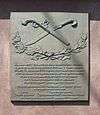 |
44°49′6″N 20°26′58″E / 44.81833°N 20.44944°E | The Southern city gate. It was through this gate that upriserers entered Belgrade to capture it in the First Serbian Uprising, after it was opened by Uzun Mirko and Ostoja Konda. | |
| Stambol Gate | 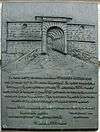 |
1723-1739[4] | 44°48′59″N 20°27′37″E / 44.81639°N 20.46028°E | The southeastern and main city gate, it was located in front of today's National Theatre of Serbia. It was built by Austria.[4] Later, the gate was used for public executions. A symbol of Turkish oppression,[4] it was demolished in April–May 1866.[4] |
| Varoš Gate |  |
44°48′59.5728″N 20°27′11.1276″E / 44.816548000°N 20.453091000°E | The gate was in the wall between Stambol and Sava gates. | |
| Vidin Gate | 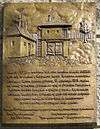 |
44°49′14″N 20°27′55″E / 44.82056°N 20.46528°E | The eastern city gate, located near today's First Belgrade Gymnasium. |
Modern gates
| Name | Photograph | Built | Location | Description |
|---|---|---|---|---|
| Eastern Gate of Belgrade |  |
1980 | 44°47′3″N 20°30′44″E / 44.78417°N 20.51222°E | A complex of three highrise residential buildings easily visible on approach to Belgrade from east on the E75 highway. |
| Western Gate of Belgrade | 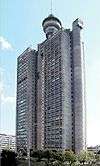 |
1977 | 44°49′13″N 20°24′17″E / 44.82028°N 20.40472°E | A highrise, easily visible on approach to Belgrade from west on the E70/E75 highway. While the building looks like a gate, having two towers connected at the top, the highway actually passes southwest of the building. |
References
- ↑ Beograd-Singidunum, treći deo
- ↑ Beograd-Singidunum, četvrti deo
- ↑ Popović, Marko (November 2012). "Капија цара Карла VI у Београду" (PDF). Nasleđe. Belgrade: Institute for Protection of the Cultural Monuments of Belgrade (XIII): 9. Retrieved 2013-12-15.
- 1 2 3 4 Rajković, Ljubinka (1973). "Још једанпут око два споменика из старог Београда" (PDF). Annual of the City of Belgrade. Belgrade: Belgrade City Museum (XX): 229. Retrieved 2013-12-06.
| Wikimedia Commons has media related to Gates of Belgrade. |